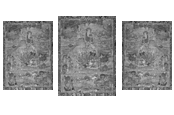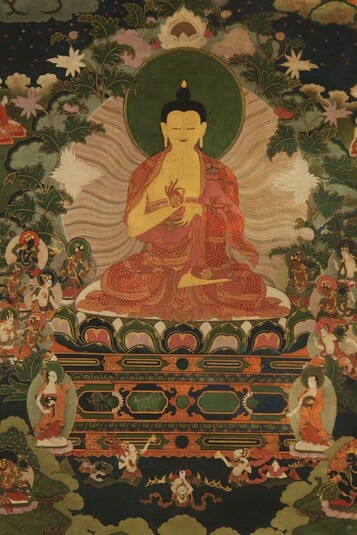
Item: Dipamkara Buddha - (Seated)
| Origin Location | China |
|---|---|
| Date Range | 1700 - 1799 |
| Lineages | Gelug and Buddhist |
| Material | Ground Mineral Pigment on Cotton |
| Collection | Private |
Classification: Deity
Appearance: Buddha
Gender: Male
Dipamkara Buddha, the previous Buddha prior to the age of Shakyamuni, and later to be followed by Maitreya. This composition likely belongs to a three painting set 'The Buddhas of the Three Times.'

The Buddha has his hands in the teaching gesture imitating a an eight-spoked wheel which he also has decorating the palms of the hands and feet. With the legs in vajra posture, he sits atop a multi-coloured lotus seat and square throne. Two attendant monks stand at the sides of the throne above a lotus pond. In the pond are three naga figures holding upraised precious wish-fulfilling gems. To the right and left of the throne are sixteen bodhisattva figures, idealized students of the Buddha originating in the Mahayana Sutras of Northern Buddhism.
At the upper right and left of the composition are sixteen Buddha figures, eight to each side, seated on billowing clouds. Additional monks are seated at the lower left and right below the Buddhas. In the bottom foreground of the composition are five human figures. Four are monastic and one is dressed in the appearance of a yogi with white robes and a meditation belt.
A Buddha is known for having thirty-two major and eighty minor distinguishing physical characteristics (marks) based on the Indian cultural description of a Universal Monarch (Chakravartin) - the highest and most developed male form. Only a few of these 112 marks are depicted in art such as the ushnisha on the top of the head, the urnakesha between the eyes, three curved horizontal lines on the neck, a Dharma Wheel impression on the palms of the hands and soles of the feet.
The identification of Dipamkara Buddha is proffered based on a process of elimination. The figure of the Buddha does not have any apparent characteristics of Shakyamuni Buddha such as the earth touching gesture. The sixteen bodhisattvas, eight to each side, are missing the signature figures associated with Shakyamuni such as Avalokita, Manjushri, Vajrapani and others. Each of the Buddhas of the Three Times would be depicted with their own set of sixteen great Bodhisattvas.
Likewise the form of the Buddha does not immediately stand out as the future Buddha Maitreya in Buddha Appearance. Typically he would be adorned on the head with a stupa, or hold a stupa and water flask. Both of these identifying symbols are missing. It is possible, based on the two kneeling gods in the lower composition and the five human figures that the central Buddha might be identified as Maitreya, the future Buddha. Lacking clear iconographic signatures or inscriptions on the front or back of the painting it is difficult to be certain.
Although a Himalayan art style painting, this composition and style can be identified as belonging to the Qianlong Period and the region can be located to the Beijing area or surrounding district. The palette of dominant dark blues and green colours along with the white bodies of the human figures are just a few of the characteristics of this 18th century style.
Jeff Watt 8-2017 [updated 9-2017]
Painting Style: Qianlong Period Painting Style
Collection of Anna Maria Rossi & Fabio Rossi
Buddhist Deity: Dipamkara Buddha
Shakyamuni Buddha: Iconographic Confusions
